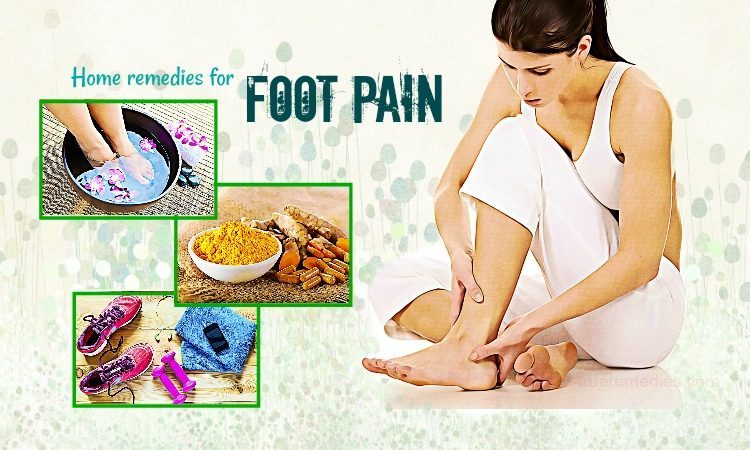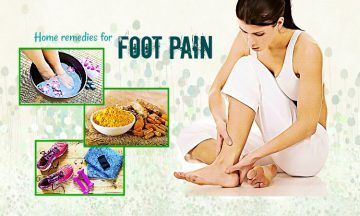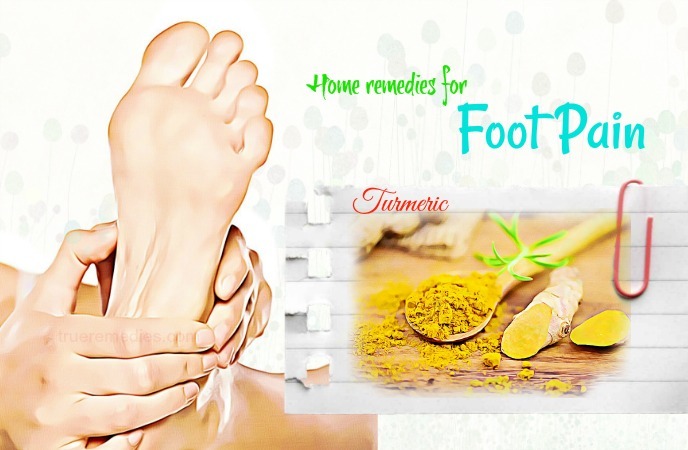updated: 11/09/2019
CONTENTS
Foot pain is a common phenomenon that most people experience in their daily lives. This is a common symptom of over-mobility or high-intensity exercise. However, the pain is not only caused by our movement but also symptoms of many other diseases. Because the foot is subjected to a great deal of pressure from the gravity of the body so when the foot pain occurs, the patient will encounter a lot of trouble. To overcome this condition, many people come to see a doctor. However, if you want to prevent this disease or your condition is not too severe, you can use some natural home remedies. Keep reading to know the best natural home remedies for foot pain and swelling relief.
What Is Foot Pain?
Foot pain is a painful condition along the front or inside of the leg. The muscles, tendons and tissue bones become overworked by increased activity. Mild symptoms may be inflammation of the soft tissue or muscle, while severe cases may be accompanied by the lightning of the shin bone. The characteristic of pain is muscle pain, which may occur at the end of the day or at different times of the day[1] [2].
What Are Common Causes Of Foot Pain?
Wearing ill-fitting shoes is the most common reason for foot pain. Other causes of foot pain may include:
- Because There Are Foreign Objects Plugged Into The Foot
When moving, the foot can be pierced by small objects, broken glass or even iron nails. Depending on the size of the object, the patient may feel pain under the soles of the foot immediately after stepping on the object or until the wound forms pus. In this case, the patient will only have pain under the soles of the right foot or pain under the soles of the left foot. An object that stabs in the foot only if it is shallow outside can be removed by hand and applied antiseptic. When a large object, large blood flow, you must not remove the object yourself. It requires temporary hemostasis and then takes the patient to the medical institution for emergency first aid.
- Because Of High Heels
When wearing high heels, the human form will be deformed, the weight of the whole body is not distributed uniformly but on the heel and the foot. As a result, the patient has pain in the soles of the feet, ankles, knees, even the spine.
TrueRemedies Partner Solutions

Need a Help from the Leading Expert Online, Available 24/7?
They’re all here and ready to answer your questions online or by phone. Keep asking questions until you get the answer you need.
- Overweight Or Obesity
It makes your foot have great pressure when weight is gained. It will cause you to be prone to problems such as foot inflammation and knee joint pain.
- People With Flat Feet
It makes the weight of the foot must touch more with the ground. Over time, the fascia is degenerated, no longer flexible. This is also the reason why people who regularly go barefoot on a hard surface are more likely to suffer from plantar fasciitis. People with too low or too high arch limbs are also more vulnerable to experience this problem.
- Job Characteristics
People who have a career that requires a lot of standing for long periods of time are more susceptible to muscle pain in their feet.
- Diabetes
It sounds unrelated but diabetes may cause the feeling in the foot to be diminished due to neurological complications. Patients with difficulty adjusting the standing position make the allocation uneven, leading to pain in the soles of the foot.
- Sciatica
The disease usually causes pain that starts from the waist (the origin of the nerve root) that spreads to one or both legs. Depending on the location of the nerve damage, the pain may spread to the outside of the thigh, leg, or soles of the foot.
- Lack Of Calcium, Vitamin D
Lack of calcium and vitamin D may cause a muscle spasm, difficult to travel.
- Sprain And Muscle Strain
Sprain and muscle strain are common injuries affecting the muscles and ligaments. The common cause for these injuries is sudden changes in direction and speed, falling or collisions with obstacles during sport. In addition to the pain, the legs may be swollen, bruised or weakened.
- Gout
Gout is a type of arthritis caused by the accumulation of uric acid crystals in the muscle or joint. Gout often presents with tenderness and pain at the base of your big toe. The pain may last for a few days and often affects the big toe muscles. People with gout may have severe leg pain, and the affected leg muscles may be red even when you are resting.
- Tendon d’Achille
Symptoms of Achilles tendonitis are swollen tendon and throbbing pain. You may notice pain after waking up and walking a few steps or after a long rest period.
- Foot Pain Due To Peripheral Neuropathy
Nervous tumors occur when a nerve is placed between the toes, usually between the third and fourth toes (from the toes), followed by the middle of the second and third toes, but rarely affect in the middle of the fourth and fifth toes. If nerve tumors are on one side of the foot, the risk of developing on both legs is about 15%. At first, the symptoms of the disease occasionally occur, but when aggravated it may happen all the time. However, you will feel better when you take off your shoes and massage your feet. This type of nerve disease is common in women between the ages of 30 and 50, often due to the incorrect size of the shoe. Symptoms of neuropathy are stinging, aching, numbness, tingling, burning, cramping, feeling like trampling on something or object inside the shoe.
What Are Common Symptoms Of Foot Pain?
Some of the main symptoms of foot pain:
- Pain is the most visible sign when the muscles, joints, ligaments in the foot, the heel hurt. Limitation of pain not only at the feet but may spread to the soles of the feet, toes, and ankles. The pain most often occurs when the patient travels. Many people have to limp, it is very difficult to walk and stand to put the gravity to the foot to reduce foot pain.
- Pain or burning in the soles of the feet or near the heel. Severe pain when standing, running or walking. Pain or numbness in the toes.
- If the cause of the disease is due to inflammation, the patient will notice swelling of the feet and abnormal red-hot phenomenon. In addition, numbness may occur when the patient has a disc herniation, which causes the nucleus of the disc to compress into the spinal column. At this time the pain, numbness will stretch from the waist down to the toes
Who Is At Risk Of Foot Pain?
- Foot pain may affect everyone, regardless of age or lifestyle. A study has shown that middle-aged men are more likely to have pain in the toes and toes as BMI increased[3]
- Young female athletes also have pain in the sole and dome of the foot.
- Heel pain often attacks women in their 40s and 50s who are sedentary.
- As you get older, your feet get worse as the fatty tissues under the sole become harder and harder on the feet, putting pressure on your toes. Therefore, older people will often have more pain in the front of the foot while the common heel pain in middle-aged women is overweight.
- Foot and nail pain is more common in men than in women, most of whom are over 55, especially with diabetes or arthritis and overweight.
When To See A Doctor?
If foot pain isn’t treated in time, it may cause long term disability and continuing damage to your foot. You should contact your doctor immediately if:
- Your foot pain continues for a long time and gets worse. Always talk to your doctor about the best diagnostic, treatment and treatment options available to you.
- You have diabetes, heart disease or other known health conditions that may be associated with foot pain.
- You have other symptoms along with foot pain.
In addition to the symptoms mentioned above, if you suffer from other diseases, you must see a doctor immediately.
Top 15 Natural Home Remedies For Foot Pain Relief
1. Physical Activities
Among home remedies for foot pain, physical activities are one of the most effective. Exercise may reduce foot pain by reducing stress, helping you lose weight, and increasing blood flow. You can apply some of the following methods to improve your situation:
Method 1: Massage
Foot massage helps increase blood flow to the legs[4]. Follow these steps below:
- Let the patient lie on his back, his legs hurt in a comfortable posture.
- Rub and spread around the pain area from the inside out, from light to strong, from top to bottom to circulate blood circulation, prevention of congestion.
- Rub from the ankle swelling down the toes to relieve swelling and pain.
- Spread from light to strong places 1 (taken above the folds in front of the ankle, in the middle between the two muscles, the foot to show the foot to clear), where 2 (located in the midpoint of the highest point the ankle and the back of the ankle) and place 3 (located in the indentation between the highest point of the ankle in the ankle and the ankle), approximately 1 minute each.
- Determine the most pain, using fingers to massage from light to strong about 2 minutes, and the patient gently moving the ankle joint.
You can use massage cream for the foot massage. Place the thumb on the tip of your foot and index finger on the heel, massage the foot clockwise, from the toe to the heel and the ankle. Then do the opposite clockwise.
Method 2: Pull The Towel
- While sitting, place one leg on the coffee table or couch in front of your feet straight.
- Round a towel or T-shirt around the foot, clenching both ends with both hands.
- Gently pull it toward you so that your calves and heels stretch.
- Hold for 15 seconds then relax, change legs.
Method 3: Stretch Ankles
- Rotate the ankles ring clockwise 10 times, then reverse.
- Switch sides, each leg 10 times.
- These exercises not only relax the ankles but also strengthen the joint muscles
2. Soak Your Foot
There are many ways to soak your foot to relieve foot pain. Each way has a different mechanism.
Note: People with hypertension (high blood pressure) or history of fainting need to be cautious with this method because it can cause lightheadedness.
Here are some methods you can apply:
Method 1: Soak Your Foot With Hot And Cold Water
Soak foot therapy with hot and cold water is an effective therapy for the treatment of foot pain. Hot water plays a role in promoting blood circulation, while cold water relieves pain and swelling[5] [6].
- Prepare a cold water bath and a hot water bath (the temperature you can tolerate).
- Sit in a comfortable chair and begin to soak in hot water for 3 minutes and then turn to cold water for about 1 minute.
- Repeat this process 2-3 times, but do not forget that the last dipping must be cold water to get the best effect.
- You can also use hot and cold water packs.
- Begin with heat and end with cold, each time about 8-12 minutes also has a leg pain relief.
Method 2: Soak Your Foot With Salted Vinegar
With antiseptic and analgesic, vinegar and salt may be the methods you need to reduce leg pain. You will need a hot water bath with 2 tablespoons of vinegar and mix in a little salt. You can use ordinary food, but if you have sea salt or Epsom salts, the pain relief will be higher. You soak in the mixture for 20 minutes and sit relaxed for the nerve to relax and feel the pain is reduced.
3. Honey
Honey contains a variety of antioxidants that help kill free radicals caused by ultraviolet rays or the aging process of the body. Honey contains many nutrients such as magnesium, potassium, and calcium. These substances are effective in regenerating and promoting the growth of cells. Therefore, it also helps to relieve pain and heal wounds[7] [8]. Apart from that, it contains an enzyme that produces hydrogen peroxide, a well-known disinfectant. A thin layer of it can be applied to the skin to disinfect and heal wounds on the skin and lips.
Method 1: No Sugar Added Honey
Consume 3-4 teaspoons of honey in the morning every day as a treatment of foot pain.
Method 2: Honey And Lemon
Lemon has anti-inflammatory properties, which help foot pain heal effectively.
- Prepare 100ml of honey, half a lemon, 300ml of warm water.
- Squeeze lemon and honey in water, stirring well.
- Drink it twice a day and 5-6 times a week
Method 3: Honey And Salt
Salt and honey are known for their beneficial anti-inflammatory and analgesic properties, which are used to treat diseases related to bone joints.
- Prepare 4 tablespoons of honey and 4 tablespoons of salt.
- Mix the honey and salt together. Then stir well.
- Apply this mixture to the pain area, fix with clean gauze and keep overnight.
- Follow it for 10 consecutive days for quick results.
4. Epsom Salt
Epsom salt also called magnesium sulfate may provide us with many health benefits and beauty. The magnesium in it imparts soothing and anti-inflammatory properties to it[9]. It can be used to reduce the symptoms of bone-related diseases. Sulfate helps remove toxins from the body. Magnesium relieves muscle pain and reduces inflammation, supporting nerve function by regulating electrolytes[10].
Method 1: Only Epsom Salt
- Mix 3 tablespoons of Epsom salts in a warm bath in a small tub.
- Soak your feet in it for 15 to 20 minutes.
- Then, dry your legs and apply some moisturizers.
- Gently massage your heels for 5 minutes.
- Repeat 2 or 3 times a week until the pain is gone completely
Method 2: Epsom Salt And Wormwood
- Prepare a bunch of wormwood leaves, rinse and roast.
- When it’s dry, add the Epsom salt and roast it.
- Pour mixture into a thin towel and apply it to the wound as soon as it is hot.
- Keeping the heat warm for a while until it is hot again and applying 2-3 times will help reduce foot pain effectively.
Method 3: Epsom Salt And Ginger
Ginger is warm, has the ability to treat inflammation, so you can use ginger to relieve pain quickly and naturally.
- Cut the ginger into thin slices and then put in a roasting pan.
- Add the salt to the roasted seeds to help keep the heat.
- After the roast, you put on a towel and put directly on the wound.
- In this way, you will quickly overcome the foot pain.
5. Turmeric
Turmeric contains a main active ingredient called curcumin, which contains medicinal properties such as analgesics, anti-inflammatory, and anti-cancer cells. Using turmeric as a treatment of foot pain is very effective thanks to its anti-inflammation[11] [12].
Method 1: Just Turmeric
- Prepare 2 to 3 teaspoons of turmeric powder and 100ml of water (use warm water about 40 degrees)
- Add turmeric powder to water and stir well.
- Each day, take 2 times before or after meals to get the results you want.
Method 2: Turmeric, Milk, And Honey
- Add 1 glass of milk and 1 teaspoon turmeric powder to the pot.
- Heat on low heat for 5 minutes.
- Add a little honey pure.
- Take 2 or 3 times a day to relieve pain.
You can also take 400 to 600 mg of turmeric powder 3 times a day. However, consult a doctor before starting any additional regimen.
6. Ginger
This sounds strange when it comes to home remedies for foot pain relief, but it works. Ginger has anti-inflammatory and analgesic properties, which all may help to relieve foot pain and inflammation[13] [14] [15]. Besides, it has a compound called gingerols so it may prevent the production of pain-triggered hormones.
Method 1: Ginger Tea
- Boil 300ml water with 4 or 5 grams ginger and then simmer for 5 to 10 minutes.
- You can also add 1 teaspoon lemon juice or honey to the ginger tea.
- Drink ginger tea from 2 to 3 times a day for the best treatment of foot pain relief.
Method 2: Ginger Oil
- Take 5 – 10 ml of ginger oil.
- Apply ginger oil to the affected area.
- Massage gently with ginger oil several times a day will be a good treatment of foot pain.
Additional Tips
The habits and lifestyle below will help you limit the progression of foot pain:
- Play tennis as a good habitat for treating foot pain
- Soak in warm water for 10-15 minutes at the end of each day, preferably soaking in warm-salt water. Warm water will relax the muscles in the legs. Salt has antifungal and bacterial properties, so warm salt water can help remove foot odor.
- Put your foot on the cold, as the cold may reduce some inflammation.
- Regularly practice exercises for strong bones to keep fit and help the body to relieve stress. You can start with gentle stretching exercises which help the muscles relax and blood circulation. Basic yoga postures, walking, on-site physical exercises, etc. are good ideas. They also bring great benefits to health.
- Choose shoes that fit comfortably with your foot.
- Rest on time, sleep at night, not to stay up late to the spirit of refreshing, comfortable, and create good psychology, confidence in life.
With these remedies, you will no longer suffer from pain. Do not doubt about their effectiveness. You will be amazed at the effects that they bring you. If you have any other home remedies for foot pain, feel free to drop your words below this post.










